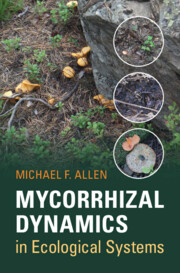Book contents
- Mycorrhizal Dynamics in Ecological Systems
- Mycorrhizal Dynamics in Ecological Systems
- Copyright page
- Contents
- Preface
- Acknowledgments
- Glossary of Key Terms
- 1 Introduction
- 2 Structure–Functioning Relationships
- 3 Evolutionary Ecology
- 4 Physiological Ecology
- 5 Population Ecology
- 6 Community Ecology
- 7 Ecosystem Dynamics
- 8 Mycorrhizae and Succession
- 9 Global Change
- 10 Conservation, Restoration, and Re-wilding
- 11 Conclusion and Summary
- Bibliography
- Index
5 - Population Ecology
Published online by Cambridge University Press: 25 March 2022
- Mycorrhizal Dynamics in Ecological Systems
- Mycorrhizal Dynamics in Ecological Systems
- Copyright page
- Contents
- Preface
- Acknowledgments
- Glossary of Key Terms
- 1 Introduction
- 2 Structure–Functioning Relationships
- 3 Evolutionary Ecology
- 4 Physiological Ecology
- 5 Population Ecology
- 6 Community Ecology
- 7 Ecosystem Dynamics
- 8 Mycorrhizae and Succession
- 9 Global Change
- 10 Conservation, Restoration, and Re-wilding
- 11 Conclusion and Summary
- Bibliography
- Index
Summary
The study of population ecology in plants is as old as the field of ecology but is more complex for fungi. Due to their microscopic morphology, identifying individuals for measuring and modeling is challenging. We have examined the general morphology of fungi and plants comprising the mycorrhizal symbiosis, and we have looked at the larger-scale evolutionary patterns that resulted in the mycorrhizae that we observe and study today. However, selection acts on the individual organism (472). An organism survives to reproduce offspring that in turn reproduce, or it does not: a binary outcome. And, an organism is comprised of a complete genetic code that allows it to survive to reproduction (or not).
- Type
- Chapter
- Information
- Mycorrhizal Dynamics in Ecological Systems , pp. 89 - 111Publisher: Cambridge University PressPrint publication year: 2022

